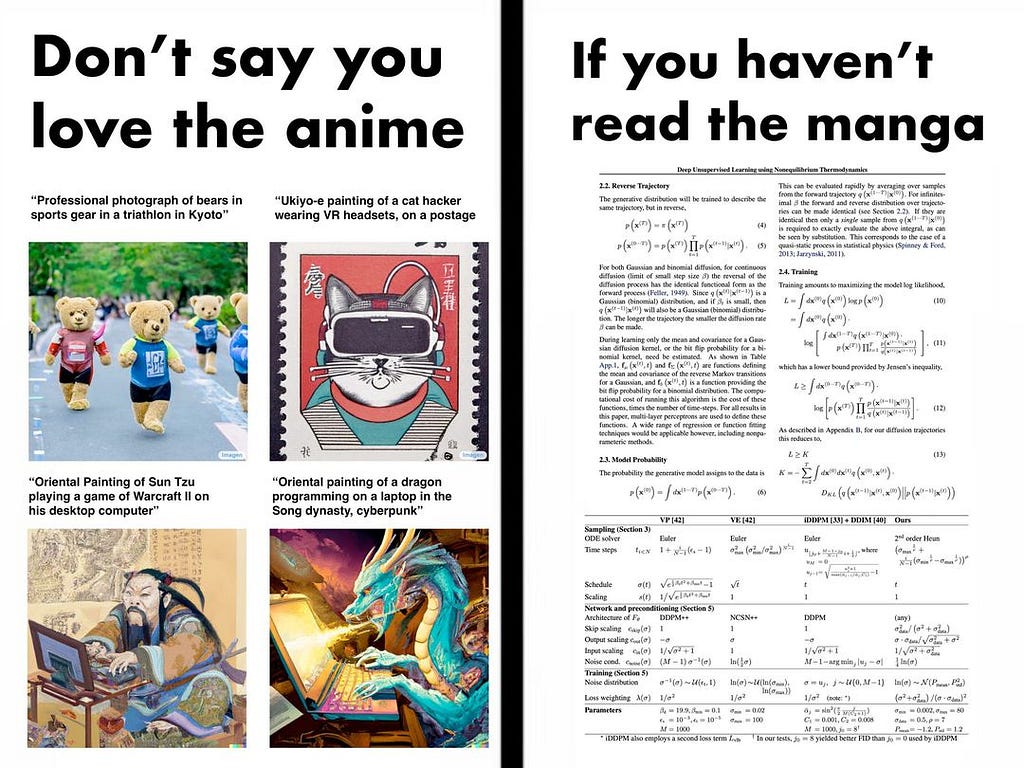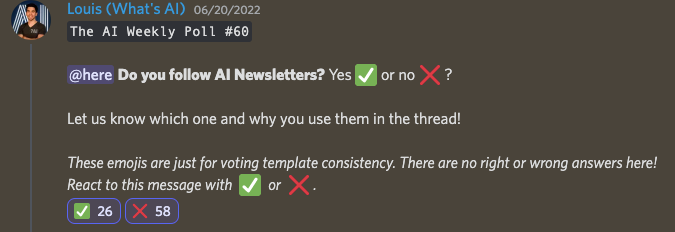
This AI newsletter is all you need | #1
Last Updated on July 5, 2022 by Editorial Team
Author(s): Towards AI Editorial Team
Originally published on Towards AI the World’s Leading AI and Technology News and Media Company. If you are building an AI-related product or service, we invite you to consider becoming an AI sponsor. At Towards AI, we help scale AI and technology startups. Let us help you unleash your technology to the masses.
As of today, we are revamping our newsletter into a weekly edition and new format more entwined with our 26,000 members strong Learn AI Together Discord Community (Join here) and our 2,000 Towards AI writer contributors. We aim to create a useful, fun, and engaging newsletter for the AI Community where we will showcase some of the most significant news items and papers of the past week, along with some of the discussions taking place in our community. We will also pick our favorite article published by our Towards AI contributor community each week — our editorial team is now publishing 20–30 articles a week from our contributors, and we want to help reward the best posts with more exposure to our 300,000 followers at Towards AI. Our format is a work in progress, so please feel free to leave any feedback in the comments on our website or reach out to us on our Discord!
What happened this week in AI
Our AI highlight this week was the DALL E mini model (now renamed craiyon) which achieved viral momentum for its production of amazing images from text inputs. The model is a free and open-source model inspired by Open AI’s DALL E models. We think this is a great showcase of what ML can now achieve in image generation even with a free model, and helps showcase the fun side of AI to the general public. Craiyon is very similar to DALL E and uses both a language module and an image module, just using different architectures and training data. It uses the BART language model to transform text input into a language understandable for the next model. It then uses an image decoder called VQGAN to use an encoding mapping and generate an image out of it. See a more detailed explanation of DALL·E Mini here.
This issue is brought to you thanks to Anyscale:

Did you know that teams at Google, Meta, IBM, Uber, and more are using Ray to scale critical AI initiatives? Or that the Qatar Computing Research Institute is using reinforcement learning and Ray RLlib to control congestion and facilitate mobility at FIFA World Cup 2022? Come see for yourself at Ray Summit. Register now to take advantage of the Early Bird rate — and use the code Ray20 to get an additional 20% off! Early Bird registration ends June 30.
Hottest news
- A new AI salary survey showed AI manager salaries now top $300,000
The survey of 1,841 professionals showed increases in mean base salaries for AI professionals from 10% to 13%. Great news for all of us, I guess! - Intel and Hugging Face Partner to Democratize Machine Learning Hardware Acceleration
Using Intel‘s Optimum open-source library, the two tech powerhouses are teaming up to build novel hardware acceleration to train, fine-tune and predict with transformers. Users will soon be able to achieve superior performance on Intel platforms with the coming advancements in model optimization tools! - New AI essentials from NVIDIA!
Looking to break into the field or take your job to the next level? NVIDIA released some great new materials for getting started in an AI career.
Most interesting papers of the week
- General-purpose, long-context autoregressive modeling with Perceiver AR A collaboration between Google Research and DeepMind: an autoregressive architecture (Perceiver AR) that is able to generate high-quality samples as long as 65k tokens — the equivalent of minutes of music, or entire pieces!
- VoxGRAF: Fast 3D-Aware Image Synthesis with Sparse Voxel Grids Sparse voxel grids have proven super useful for speeding up novel view synthesis: inspired by this, their work uses a sparse voxel grid representation for fast and 3D-consistent generative modeling and “allows for efficient rendering from arbitrary viewpoints while yielding 3D consistent results with high visual fidelity.”
- Video PreTraining (VPT): Learning to Act by Watching Unlabeled Online Videos With a small amount of labeled data we can train an inverse dynamics model accurate enough to label a huge unlabeled source of online data — here, online videos of people playing Minecraft — from which we can then train a general behavioral prior.
Enjoy these papers and news summaries? Get a daily recap in your inbox!
The Learn AI Together community section!
Meme of the week!

Featured community post from the Discord
One of our members just passed the Azure AI fundamentals exam!
Congrats Jatamer!
“This exam is an opportunity to demonstrate knowledge of machine learning (ML) and artificial intelligence (AI) concepts and related Microsoft Azure services. Candidates for this exam should have familiarity with Exam AI-900’s self-paced or instructor-led learning material.
This exam is intended for candidates with both technical and non-technical backgrounds. Data science and software engineering experience are not required; however, awareness of cloud basics and client-server applications would be beneficial.”
AI poll of the week!

TAI curated section
Article of the week
Conditional Probability and Bayes’ Theorem Simply Explained: Every AI enthusiast has struggled with statistics at some point in their lives. This article gives the most straightforward and intuitive explanation of conditional probability and Bayes’ theorem, which is essential knowledge for any AI engineer. You will be very comfortable with all kinds of probabilities and Bayes’ Theorem by the end of this article.
If you are interested in writing for us at Towards AI, please sign up here and we will publish your blog to our network if it meets our editorial policies and standards.
Lauren’s ethical take on Dall-E Mini
We’ve seen some pretty creative uses of DALL E Mini/craiyon recently, many of which are hilarious and some of which codify less savory parts of AI. Elements of algorithmic bias can be seen in some generations, for example, a keyword entry of “a normal woman” yielding only depictions of white women. This is no new problem for image generation AI, and it is largely a reflection of the data it was trained on. It’s important to recognize that flaws are present and this awareness can help us learn to mitigate problems better.
On a more uplifting note, it’s a significant ethical good that the DALL E Mini/craiyon has brought so much joy through memes! Making AI accessible is what we support, and this helps accomplish that in a humorous way. Share your best AI memes with us on Discord!
Featured jobs this week
Senior ML Engineer — Algolia AI @ Algolia (Hybrid remote)
Senior ML Engineer — Semantic Search @ Algolia (Hybrid remote)
Machine Learning Engineer @ Gather AI (Remote — India)
Deep Learning Engineer (R&D — Engineering) @ Weights & Biases (Remote)
Machine Learning Intern @ Weights & Biases (Remote — USA)
Machine Learning Engineer — Prediction @ Zoox (Foster City, Canada)
Software Engineer — Machine Learning @ Zoox (Foster City, Canada)
This AI newsletter is all you need | #1 was originally published in Towards AI on Medium, where people are continuing the conversation by highlighting and responding to this story.
Join thousands of data leaders on the AI newsletter. It’s free, we don’t spam, and we never share your email address. Keep up to date with the latest work in AI. From research to projects and ideas. If you are building an AI startup, an AI-related product, or a service, we invite you to consider becoming a sponsor.
Published via Towards AI
Take our 90+ lesson From Beginner to Advanced LLM Developer Certification: From choosing a project to deploying a working product this is the most comprehensive and practical LLM course out there!
Towards AI has published Building LLMs for Production—our 470+ page guide to mastering LLMs with practical projects and expert insights!

Discover Your Dream AI Career at Towards AI Jobs
Towards AI has built a jobs board tailored specifically to Machine Learning and Data Science Jobs and Skills. Our software searches for live AI jobs each hour, labels and categorises them and makes them easily searchable. Explore over 40,000 live jobs today with Towards AI Jobs!
Note: Content contains the views of the contributing authors and not Towards AI.













